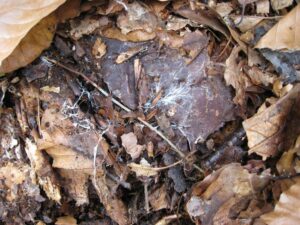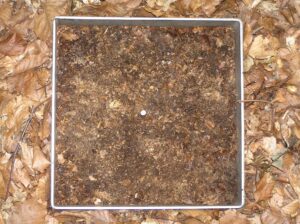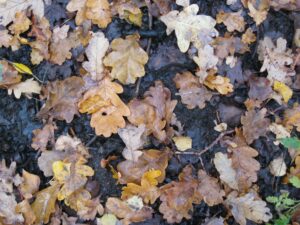Olf
Of transition horizon (Ol-Of), in which the macroscopically detectable needle and leaf debris predominates over the organic fine matter (Figure 7b).
[l from litter]
- organic carbon content ≥ 15 mass % and
- developed under aeromorphic to aero-hydromorphic conditions
- Proportion of organic fine matter 10 – < 30 vol.%
Ohf
Of transition horizon (Oh-Of) with a high to predominant proportion of organic fine matter and lower proportions of macroscopically recognisable remains of dead plant biomass/litter (Figure 7c).
[h from humified]
- organic carbon content ≥ 15 mass % and
- developed under aeromorphic to aero-hydromorphic conditions
- Proportion of organic fine matter 30 – < 70 vol.%
Ohf horizont, leaf material: common beech (Fagus sylvatica)
© Gerhard Milbert
Odf
Of modified horizon with root felt.
[d from „stark durchwurzelt“ (german for strong rooting)]
- organic carbon content ≥ 15 mass % and
- developed under aeromorphic to aero-hydromorphic conditions
- Proportion of living fine roots ≥ 50 vol.%
Owf
Of modified horizon, temporarily influenced by stagnic water or groundwater. Vegetation indicates wetness in the A horizon (Figure 14).
[w from water influenced]
- organic carbon content ≥ 15 mass % and
- developed under aeromorphic to aero-hydromorphic conditions
- Proportion of living fine roots ≥ 50 vol.%
- temporarily anaerobic conditions and
- grey to black colouring of the litter and
- above recently water influenced hydromorphic A or H horizon



